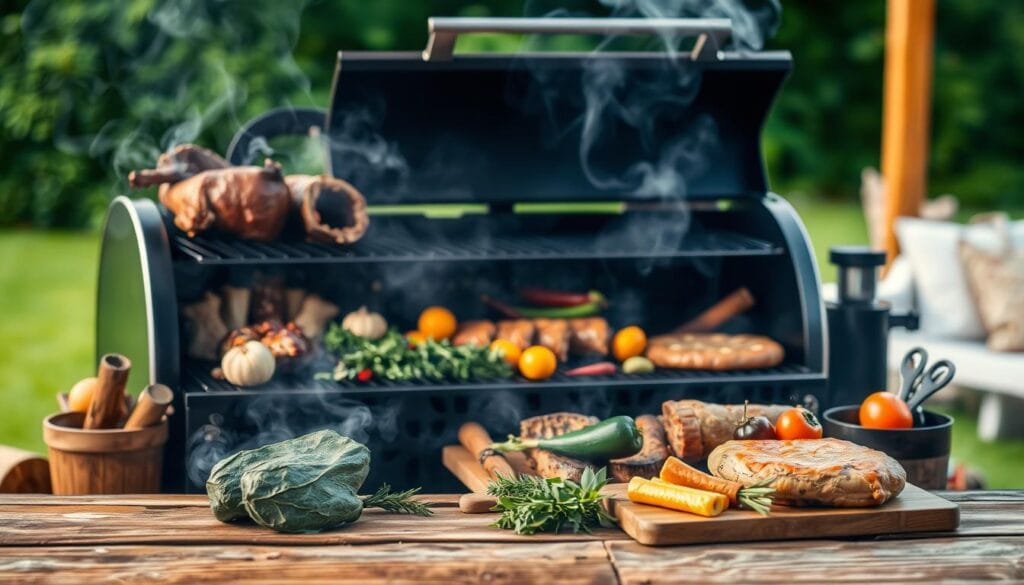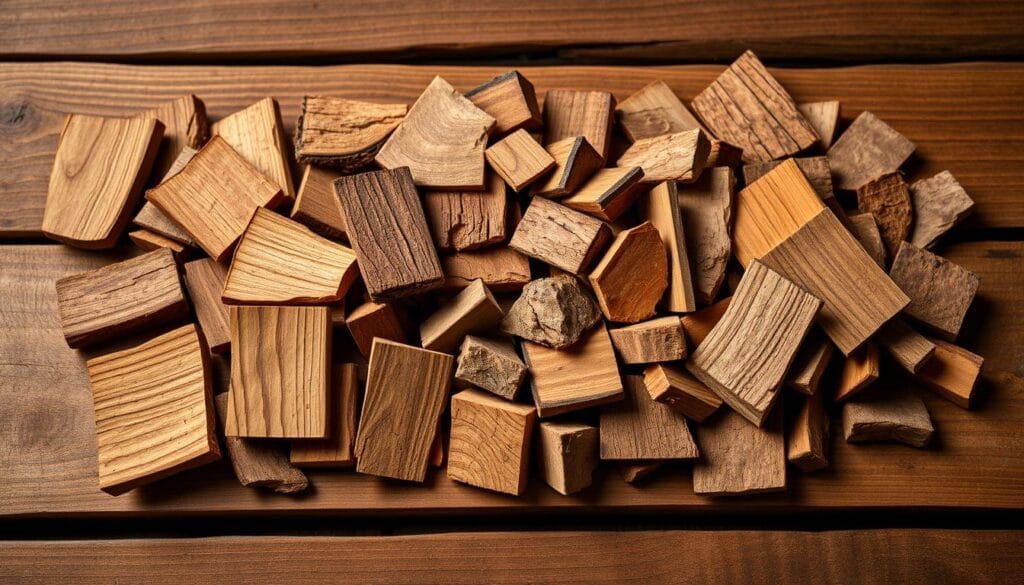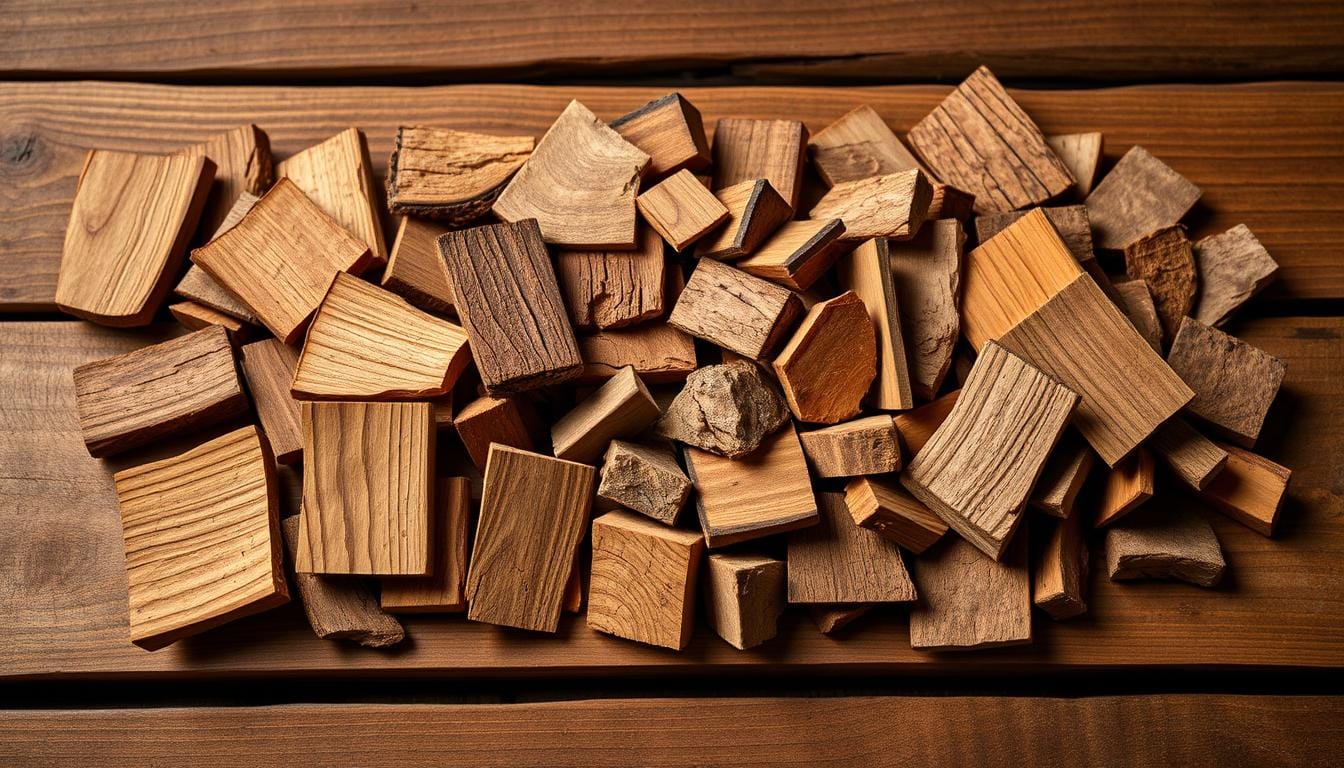Best Smoker Recipes for Flavorful Outdoor Cooking

Explore the amazing world of smoker recipes and change how you cook outside. Smoked meats are more than food; they’re a journey of flavors. They add depth to your favorite dishes. Whether you love BBQ or just want to try something new, smoking food is exciting.
Smoking is not just cooking; it’s an art that needs patience, skill, and love. With the right techniques, simple ingredients become incredible dishes. Your friends and family will ask for more. You can make tender brisket and juicy chicken like a pro.
Key Takeaways
- Discover the transformative power of smoke-infused cooking
- Learn techniques to create restaurant-quality smoked meats at home
- Understand the basics of smoker selection and setup
- Explore flavor profiles and wood chip varieties
- Master temperature control for perfect results
Getting Started with Your Smoker: Essential Equipment and Setup
Starting your smoker cooking journey can change your backyard BBQ game. Choosing the right smoker and knowing how to set it up are key steps. This guide will help you pick the right equipment and learn the basics.

Smoking meat is an art that needs the right tools and knowledge. Your first step is picking a smoker that fits your cooking style and needs.
Types of Smokers for Different Cooking Needs
There are many types of smokers:
- Charcoal Smokers: Perfect for traditional flavor enthusiasts
- Electric Smokers: Ideal for beginners and consistent temperature control
- Pellet Smokers: Offers convenience and precise temperature management
- Propane Smokers: Great for outdoor cooking with easy heat regulation
Must-Have Smoking Accessories and Tools
To improve your smoking experience, get these essential tools:
- Digital meat thermometer
- Heat-resistant gloves
- Aluminum drip pan
- Long-handled tongs
- Quality wood chips for smoking
Setting Up Your Smoker for First Use
Setting up your smoker right is key for great smoking. Start by cleaning and seasoning your smoker before your first use. This removes factory residues and prevents rust.
Pro tip: Always read your smoker’s manual carefully and follow manufacturer’s specific instructions for initial setup and seasoning.
Knowing your equipment is the first step to becoming a smoking pro. With the right tools and knowledge, you’ll soon be making delicious, smoke-infused meals.
The Best Wood Chips for Smoking Different Foods

Choosing the right wood chips can change how you enjoy food. Each wood type adds a special flavor to your dishes. This makes your meals not just good, but amazing.
Knowing about wood chips is key to great taste. Different woods pair well with different foods in unique ways:
- Hickory: Gives a strong, bacon-like taste that’s great for pork and beef
- Apple: Offers a mild, sweet smoke that’s perfect for poultry and fish
- Mesquite: Provides a bold, intense flavor that’s best for red meats
- Cherry: Adds a subtle, fruity flavor that’s great for chicken and turkey
Here are some tips for using wood chips in your smoker recipes:
- Soak wood chips in water for 30 minutes before using them
- Mix different wood types to create unique flavors
- Start with small amounts of wood chips to control the smoke
- Replace wood chips when they stop producing smoke
Try different wood chip mixes to find your own smoking style. The right wood can turn your dishes into something truly special.
Basic Smoker Recipes for Beginners
Starting with smoker recipes might seem scary, but it’s easy with the right help. Whether you’re new or want to get better, these recipes will teach you to smoke meats and fish well.
Smoking meat needs patience and skill. It’s all about controlling the temperature, picking the right wood chips, and getting your ingredients ready. Try these simple recipes to wow your loved ones.
Simple Smoked Chicken Recipe
Chicken is great for beginners to practice with. You can use a whole chicken or cut pieces for easier smoking. Here’s what you need to do:
- Brine the chicken for extra moisture
- Make a tasty dry rub
- Keep the smoker at 225°F
Easy Smoked Pork Shoulder
Pork shoulder is perfect for beginners. It’s easy to work with and tastes amazing. Here’s how to do it:
- Choose a good pork shoulder
- Put on a strong spice rub
- Smoke it low and slow for tenderness
Beginner-Friendly Smoked Fish Recipes
Smoking fish is a gentle way to start with seafood. Salmon and trout are great for beginners. Here’s what you need to know:
- Cure the fish before smoking
- Use mild wood chips like apple or cherry
- Watch the internal temperature closely
These smoker recipes are a great way to improve your skills and make dishes everyone will love.
Mastering Temperature Control in Your Smoker
Getting the perfect smoker temperature is key to delicious smoked meats. It turns any cook into a pro, making sure your food is tender and full of flavor. This is how you impress your loved ones.
First, know your smoker. Each one needs a special way to control temperature. Here are some tips to keep your cooking spot on:
- Use a reliable digital thermometer to monitor internal smoker temperature
- Learn to adjust air vents for precise heat management
- Understand the impact of external weather conditions on smoker performance
- Practice steady fuel management for consistent heat
Water pans are essential for keeping the temperature steady. They add moisture and prevent temperature swings. This keeps your meat juicy and flavorful.
Charcoal or wood smokers need two heat zones. One for direct heat and another for indirect cooking. This method helps control the temperature and prevents burning. Most meats cook best between 225°F and 250°F.
Remember, patience is key in smoker temperature control. Small, gradual adjustments are better than drastic changes that can disrupt your cooking process.
For the advanced, digital temperature controllers are a game-changer. They automatically adjust airflow for consistent heat. This makes achieving top-notch results easier than ever.
Pro tip: Always keep a log of your smoking sessions to track temperature patterns and improve your technique with each cook.
Essential BBQ Marinades and Rubs for Smoked Meats
Take your smoked meats to the next level with the right bbq marinades. The perfect mix of flavors can turn simple cuts into amazing dishes. These will wow your guests at any backyard cookout.
Learning about bbq marinades and rubs is key to making tasty smoked meats. These methods tenderize meat, keep it moist, and add deep flavors. They make your favorite cuts even better.
Crafting Perfect Dry Rub Combinations
Dry rubs are the base for delicious smoked meats. A good dry rub usually has:
- Kosher salt for base seasoning
- Brown sugar for caramelization
- Paprika for color and mild sweetness
- Garlic powder for depth
- Black pepper for heat
Wet Marinade Secrets for Juicy Meats
Wet marinades add another layer to your smoked meats. Liquid-based marinades break down muscle fibers, making meat tender and flavorful. Mix:
- Olive oil as a base
- Acid components like vinegar or citrus
- Fresh herbs for brightness
- Worcestershire sauce for umami
Injection Marinade Pro Tips
Injection marinades are great for big cuts of meat. They let flavors go deep into the meat. Use a meat injector to spread marinades evenly, making your smoked meats rich and consistent.
Pro tip: Always let your marinated meats rest for at least 2-4 hours before smoking to maximize flavor absorption.
Advanced Smoked Meat Techniques and Recipes
Ready to take your smoked meats to the next level? Advanced smoking techniques can turn simple cuts into amazing dishes. Professional pitmasters use special methods to make smoked meats truly spectacular.
Learn these advanced smoker recipes with these key techniques:
- 3-2-1 Ribs Method: A foolproof technique for fall-off-the-bone tender ribs
- Reverse Searing: Create perfect crust and even internal temperature
- Double Smoking: Intensify flavor profiles for complex taste layers
Big cuts like brisket and whole turkey need careful planning. Your strategy must balance temperature, moisture, and flavor. Patience becomes your most critical ingredient.
“Great smoked meats aren’t made – they’re carefully crafted with skill and passion.”
Here are some impressive smoked meats recipes to try:
- Smoked Meatloaf with Bacon Glaze
- Bacon-Wrapped Smoked Jalapeño Poppers
- Succulent Smoked Beef Cheeks
Each recipe needs careful attention. Look for the smoke ring – a pinkish layer that shows perfect smoking. Your aim is to get restaurant-quality results from your backyard smoker.
Exploring Smoked Vegetables and Side Dishes
Smoking vegetables turns simple produce into amazing dishes. It adds a unique taste that makes any meal better. Whether you’re new to smoker recipes or an expert, smoking veggies is a fun adventure.
To get the best results, you need to know which veggies work best. Also, how to prepare them for smoking is key.
Root Vegetables for Smoking
Root veggies are great for smoking because they soak up flavors well. Here are some top picks:
- Potatoes: Get a smoky inside and crispy outside
- Carrots: Taste sweet and caramelized
- Beets: Become rich and earthy
- Parsnips: Taste nutty and complex
Smoked Corn and Garden Vegetables
Garden veggies add color and fresh taste to your smoker recipes. Try these for your next dish:
| Vegetable | Smoking Time | Recommended Wood |
|---|---|---|
| Corn on the Cob | 30-45 minutes | Hickory |
| Bell Peppers | 20-30 minutes | Apple Wood |
| Zucchini | 15-25 minutes | Cherry Wood |
Creating Smoky Vegetable Medleys
Mix different veggies for stunning medleys. Pro tip: Cut them the same size for even cooking. Drizzle with olive oil and seasonings before smoking.
Smoked veggies are great hot or cold. They’re perfect in salads, grain bowls, pasta, and as side dishes. They’ll wow your guests.
Creative Smoked Appetizers and Party Foods
Take your party food to the next level with smoker recipes. These recipes turn simple appetizers into amazing bites. They’re perfect for impressing guests and making unforgettable food moments. Whether it’s a backyard barbecue or a game day, these dishes will make your menu stand out.
Picture this: smoked chicken wings with a crunchy outside and soft inside. Or smoked stuffed mushrooms filled with creamy cheese and herbs. These dishes add deep, rich flavors that regular cooking can’t match.
Try something new with smoker recipes like smoked deviled eggs or nuts. Mix in unexpected ingredients like smoked cheese dips or garnishes for cocktails. The trick is mastering temperature and wood chip choices to make dishes that wow everyone. Your guests will love the bold flavors you bring to the table.
Pro tip: Begin with easy smoked appetizers and then try more complex ones. Experiment with different smoking methods, wood chips, and seasonings. Over time, you’ll become a pro at making stunning party foods that highlight the magic of smoke cooking.
FAQ
What type of smoker is best for beginners?
Beginners should start with an electric or pellet smoker. These are easy to use and control. Electric smokers keep the heat steady, while pellet smokers offer great taste and simplicity. Think about your budget, space, and how much time you want to spend learning.
How long does it take to smoke different types of meat?
Smoking times vary by meat type and size. A whole chicken takes 3-4 hours, a pork shoulder 8-10 hours, and a beef brisket 12-16 hours. Always check the meat’s internal temperature with a thermometer for safe and tasty results.
What are the best wood chips for smoking different meats?
Different meats need different wood chips. Hickory is good for pork and beef, apple wood for chicken and fish, mesquite for beef, and cherry wood for most meats. Try different combinations to find your favorite flavors.
Do I need to soak wood chips before using them?
Soaking wood chips is optional. It can slow down burning but also helps prevent smoke from coming out too fast. You can also use a water pan in your smoker instead of soaking the chips.
How do I maintain consistent temperature in my smoker?
Keeping a steady temperature takes practice. Use a good thermometer, manage your vents, and don’t open the smoker too often. For charcoal smokers, add new coals as needed. Follow the maker’s instructions for electric or pellet smokers.
Can I smoke vegetables and other non-meat foods?
Yes! You can smoke many foods, not just meat. Vegetables like corn, bell peppers, and potatoes can be smoked. They usually need less time and can take on great flavors from wood chips. Just be careful not to over-smoke them.
What’s the difference between a dry rub and a marinade?
A dry rub is a mix of spices and herbs you rub on the meat. A marinade is a liquid that you soak the meat in. Dry rubs create a flavorful crust, while marinades add flavor inside the meat.
How do I prevent my smoked meats from becoming too dry?
To keep meats juicy, try brining before smoking, use a water pan, and check the internal temperature. Avoid overcooking. Wrapping meats in foil during cooking can also help keep them moist.
What safety precautions should I take when smoking food?
Always use a meat thermometer to check for safe temperatures. Clean your smoker often, wear heat-resistant gloves, and work in a well-ventilated area. Keep a fire extinguisher nearby. Use separate cutting boards and utensils for raw and cooked foods.
Can I use my smoker year-round?
Yes! Modern smokers work in all weather. For outdoor smokers, use a cover and create a windbreak in cold months. Electric and pellet smokers are great for year-round use because they control temperature well.

